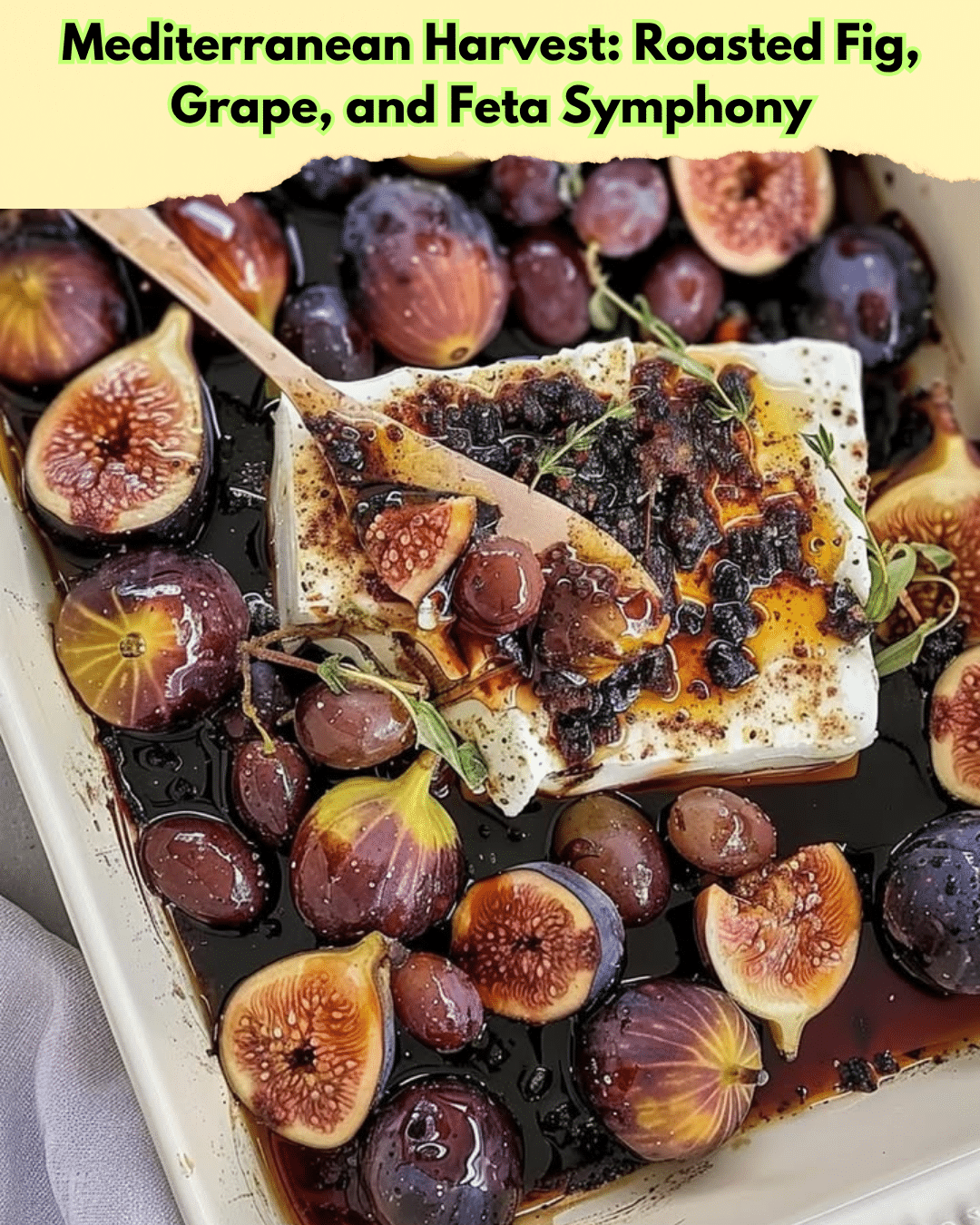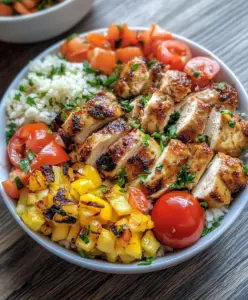Mediterranean Harvest: Roasted Fig, Grape, and Feta Symphony
Welcome to a delightful culinary escape with our Mediterranean Harvest: Roasted Fig, Grape, and Feta Symphony. This recipe beautifully combines sweet, juicy figs, and grapes with tangy feta cheese, creating a flavor explosion that is sure to tantalize your taste buds. The Mediterranean flavors and fresh ingredients make this dish a perfect choice for those seeking a gourmet yet easy meal option.
The roasted fig, grape, and feta symphony capitalizes on the natural sweetness of ripe fruits paired with savory and rich feta. Imagine the luscious warmth and complex flavors created when these ingredients are roasted to perfection, with every bite offering a symphony of taste and texture. This dish is as visually appealing as it is delicious, making it ideal for impressing guests at dinner parties or simply enjoying a peaceful night in.
Quick Recipe Highlights
Flavor Profile: Enjoy the combination of sweet and savory with the subtle tanginess of feta blending perfectly with roasted figs and grapes. The sweetness from the roasted fruits intensifies, creating a rich and harmonious balance of flavors.
Texture: Experience a delightful contrast with the soft, juicy texture of roasted fruits against the crumbly and creamy feta. This balance ensures every bite is a textural journey.
Aroma: The warm, inviting aroma of roasted figs and grapes fills the kitchen, with a hint of earthy undertones that transports you to a Mediterranean garden.
Visual Appeal: This dish presents a brilliant array of colors from the deep purples and reds of the roasted fruits to the pure white of the crumbled feta, all accented with glistening olive oil shine.
Skill Level Needed: This recipe is perfect for all skill levels, with simple steps requiring minimal advanced cooking techniques, making it accessible to beginners and experts alike.
Special Equipment: No special equipment is needed beyond a standard oven, a baking sheet, and a sharp knife for slicing—keeping it simple and efficient.
Recipe Overview
Difficulty Level: Easy. This recipe is straightforward, with no advanced culinary techniques required, making it accessible for home cooks at any skill level.
Category: This versatile creation fits into categories such as appetizers, side dishes, or even light main courses due to its balanced nutritional profile.
Cuisine: A true testament to the Mediterranean culinary tradition, this dish exemplifies the simple yet profound flavors characteristic of the region’s cuisine.
Cost: The overall cost is moderate, with fresh produce and feta cheese being the main expenses, but yielding generous servings.
Season: Best enjoyed in late summer to early fall when figs and grapes are in season, ensuring maximum flavor and freshness.
Occasion: Suitable for a range of occasions from casual family gatherings to more elaborate seasonal dinners, guaranteed to impress and satisfy.
Why You’ll Love This Recipe
Taste and Texture Appeal: The combination of roasted figs and grapes with creamy feta provides a satisfying and indulgent culinary experience. The interplay of sweet and savory flavors entices the palate, while the textures offer a delightful mouthfeel with every bite.
Convenience and Preparation Benefits: With just a few simple steps and minimal prep time, this dish is convenient for busy days or unexpected company. Ingredients are easy to source, requiring no specialty items or advanced techniques.
Nutritional Advantages: Packed with vitamins, minerals, and antioxidants from the fruits, this recipe also provides protein and calcium from the feta, making it a wholesome addition to any meal plan.
Social and Entertaining Value: Its stunning presentation and gourmet flavors make it a crowd-pleaser at social events, helping you to host elegant gatherings effortlessly.
Cost-effectiveness and Accessibility: Using readily available ingredients like figs, grapes, and feta, this dish remains budget-friendly while providing a gourmet experience without the gourmet price tag.
Historical Background and Cultural Significance
Origin Story: Rooted in Mediterranean cuisine, this recipe pays homage to the rich culinary heritage of the region, where figs and grapes have been harvested and enjoyed for centuries.
Cultural Importance: Figs and grapes hold cultural and historical significance in the Mediterranean, often symbolic of prosperity and abundance, appearing frequently in traditional feasts and celebrations.
Evolution of the Recipe: Over time, the combination of these ingredients has evolved, adapting to modern tastes while maintaining its core essence rooted in simplicity and freshness.
Regional Variations: Across various Mediterranean countries, you can find similar dishes where local ingredients are used to enhance or modify the classic combination, offering a taste of the region’s diversity.
Ingredient Deep Dive
Figs: Culturally significant in many ancient societies, figs are treasured for their sweet flavor and health benefits, rich in dietary fiber and essential minerals. When selecting figs, look for plump, tender fruit; store in the refrigerator for up to five days.
Grapes: Traditionally symbolic of abundance, grapes are a staple in Mediterranean diets. Nutritionally, they offer antioxidants and vitamin C. Choose grapes that are firm and richly colored, and store them in a refrigerator crisper drawer.
Feta Cheese: Known for its tangy flavor, feta cheese is a staple in Greek cuisine. It provides calcium, protein, and a distinctive flavor. Choose genuine Greek feta for authentic taste, and store in brine to maintain freshness.
Common Mistakes to Avoid
Over-roasting the fruits, which can burn and lose their natural sweetness, should be avoided. Keep an eye on the oven and ensure even roasting.
Choosing underripe figs or grapes might result in a lack of sweetness and depth of flavor; prefer ripe, seasonal produce for the best results.
Using low-quality feta may result in a bland dish; opt for authentic Greek feta for unrivaled flavor.
Failing to allow the roasted ingredients to cool slightly before adding feta can cause the cheese to melt and lose its appealing texture.
Not tasting before serving and adjusting for seasoning may result in an unbalanced dish; always taste and refine as needed.
Skipping the olive oil or using an inferior quality one can impact the dish’s overall richness and taste.
Ignoring portion control can lead to overwhelming flavors; balance fruit, feta, and accompanying elements proportionately.
Neglecting garnishing opportunities can diminish visual appeal; consider fresh herbs like mint or basil for an aromatic touch.
Essential Techniques
Roasting: Roasting intensifies flavors, and mastering it ensures the natural sweetness of the figs and grapes shines. Keep fruits in a single layer to promote even caramelization.
Balancing Flavors: A keen sense of taste is needed to blend the sweetness of fruit with the tanginess of feta; adjust quantities and seasoning to achieve harmony.
Judging Ripeness: Key to optimal flavor is selecting perfectly ripe produce; soft to the touch and fragrant fruits yield the best results.
Temperature Control: Proper temperature settings are crucial; preheating the oven and monitoring the temperature ensures consistent cooking.
Pro Tips for Perfect Mediterranean Harvest
Select high-quality ingredients, focusing on seasonality and ripeness for superior taste and aroma.
Consider adding a touch of honey post-roasting for extra sweetness and caramelization, enhancing the dish’s complexity.
For added crunch, sprinkle some toasted nuts like walnuts or almonds before serving, offering textural contrast.
Experiment with fresh herbs; mint or thyme can introduce an aromatic depth and freshness to the dish.
Serve at room temperature to allow flavors to meld and the harmonious blend of sweet and savory to prevail.
Variations and Adaptations
Regional variations might include using balsamic glaze to add a tangy depth or incorporating local cheeses like goat’s cheese for a distinct flavor profile.
For a seasonal twist, substitute fruits with available seasonal produce, maintaining the dish’s adaptation to local growing cycles.
For dietary modifications, replace feta with a vegan cheese alternative, preserving the recipe’s essence while making it suitable for vegetarians.
For enhanced flavor, experiment with spices such as cinnamon or nutmeg to add warmth and complexity to the roasted fruit.
Texture modifications can include incorporating roasted nuts or seeds to introduce additional layers of crunch.
Serving and Presentation Guide
Plating Techniques: Use contrasting dishes, like dark plates, to highlight the vibrant colors of the fruit and feta.
Garnishing Ideas: A sprinkle of fresh herbs or a drizzle of honey can elevate visual appeal and flavor.
Traditional Accompaniments: Serve alongside crusty bread or as part of a mezze platter for a traditional touch.
Modern Serving Suggestions: Consider individual servings for an elegant, contemporary presentation, highlighting the dish’s artisanal qualities.
Temperature Considerations: Ensure that the dish is served warm or at room temperature; extreme heat or cold can alter flavors and textures.
Portion Control Tips: Balance the quantity of sweet fruits with savory cheese for a harmonious tasting experience.
Wine and Beverage Pairing
Wine Pairings: Complement the dish with a crisp white wine like Sauvignon Blanc or a light red like Pinot Noir, enhancing the fruits’ natural sweetness.
Non-alcoholic Alternatives: Sparkling water with citrus zest or a well-crafted herbal iced tea can balance the dish’s flavors.
Coffee/Tea Pairings: A light herbal tea, such as chamomile, can harmonize with the dish’s sweet and savory notes.
Temperature Considerations: Serve beverages slightly chilled to contrast with the warm or room-temperature dish.
Serving Suggestions: Present in stemware or elegant glasses to enhance the dining experience and aesthetic pleasure.
Storage and Shelf Life
Storage Methods: Store leftovers in an airtight container to preserve moisture and flavor.
Temperature Requirements: Refrigerate promptly to maintain freshness and avoid spoilage.
Container Recommendations: Use glass containers to prevent unwanted flavors from plastic permeating the ingredients.
Signs of Spoilage: Look for discoloration or off-odors as signs of deterioration and discard if present.
Reheating Instructions: Gently reheat in the oven, but it’s best served fresh to retain optimal texture and flavor.
Freezing Guidelines: Not recommended due to the delicate nature of the fruits, which may not withstand freezing and thawing well.
Make Ahead Strategies
Prep Timeline: Prepare fruits ahead of time but roast closer to serving to ensure peak freshness.
Storage Between Steps: Keep prepped ingredients separate in sealed containers in the fridge to preserve their individual qualities.
Quality Impact Assessment: Keeping components separate ensures flavors and textures remain vibrant until combined.
Assembly Tips: Assemble the dish just before serving to maintain structural integrity and aesthetic appeal.
Reheating Guidelines: Ideally prepare fresh, but if needed, reheat gently to avoid overcooking.
Fresh Element Additions: Top with a last-minute sprinkle of fresh herbs or a drizzle of olive oil to refresh spent flavors.
Scaling Instructions
Halving the Recipe: Easily adjust ingredient quantities while maintaining cooking times and temperature for smaller servings.
Doubling or Tripling: When increasing quantity, ensure even distribution on baking sheets for consistent roasting.
Equipment Adjustments: Larger batches may require additional baking trays or rotation for uniform heating.
Timing Modifications: Monitor closely, as larger volumes may slightly extend cooking times.
Storage Considerations: Larger quantities should be stored in multiple containers to maintain freshness and accessibility.
Nutritional Deep Dive
Macro Breakdown: Balanced macronutrient profile with moderate carbs from fruits and protein from feta cheese.
Micronutrient Analysis: Provides vitamin C from grapes and calcium from feta, supporting overall health.
Health Benefits: Offers dietary fiber, promoting digestion alongside several essential nutrients.
Dietary Considerations: Suitable for vegetarians and adaptable to other dietary needs with minor adjustments.
Portion Analysis: Logical portions help maintain nutritional balance without excessive calorie intake.
Weight Management Tips: Integrate into a balanced diet with mindfulness of portions for health-conscious dining.
Dietary Adaptations
Gluten-free: Naturally gluten-free, requiring no modifications to enjoy within a gluten-free lifestyle.
Dairy-free: Substitute feta with dairy-free alternatives like almond or soy-based cheeses for lactose-sensitive diners.
Vegan: Adapt with vegan cheese options, ensuring a plant-based Mediterranean feast.
Low-carb: Reduce grape quantity or replace with lower-carb fruits like berries for carb-conscious enjoyment.
Keto: Menus can be adjusted to fit keto by controlling fruit portions and bolstering with high-fat ingredients.
Paleo: With minor adjustments such as cheese replacement, this dish can symbiotically fit into a paleo diet.
Low-FODMAP: Modifications to fruit quantities and selections ensure suitability for FODMAP-sensitive individuals.
Troubleshooting Guide
Texture Issues: Ensure proper roasting times to prevent sogginess and achieve desired caramelization.
Flavor Balance: Taste before serving, adjusting seasoning and sweetness levels for a harmonious profile.
Temperature Problems: Correct oven temperatures mitigates under or overcooking, maintaining all intended textures.
Equipment Challenges: Choose appropriate cookware for even roasting to avoid uneven cooking results.
Ingredient Substitutions: Use recommended or proven substitutes to maintain the dish’s integrity and intent.
Timing Concerns: Adhere to timing guidelines for efficient kitchen workflow and impeccable final results.
Recipe Success Stories
Community Feedback: Many have delighted in the ease and beauty of this recipe, sharing success stories from various occasions.
Variation Successes: Readers have shared successful adaptations, incorporating local and seasonal elements.
Adaptation Stories: Successfully adjusted for dietary needs, maintaining full flavor without compromise.
Reader Suggestions: Readers’ creative tips further enhance the dish, ensuring boundless possibilities.
Photography Tips: Capture the dish under natural light for vibrant colors and textures to shine.
Frequently Asked Questions
Ideally, choose fresh, ripe figs like Black Mission or Kadota for optimal sweetness and flavor.
Can this dish be served cold?
While it can be served cold, room temperature or slightly warm allows flavors to meld perfectly.
Can I use a different cheese besides feta?
Yes, goat cheese can be used for a milder, creamy alternative, maintaining the Mediterranean essence.
Is this recipe child-friendly?
Given the sweet flavor profile, children often enjoy this dish, especially when served in smaller portions.
Do grapes need to be seedless?
Yes, seedless grapes are recommended for ease of eating and consistent texture.
Can I add meat to this dish?
Incorporating prosciutto or pancetta can add a savory depth while maintaining overall harmony.
What’s the key to perfect roasting?
Ensure even spacing on the baking sheet for uniform cooking, preventing over or under-roasting.
Can leftovers be repurposed?
Leftovers can be used in salads for a critical flavor note or atop flatbreads for a revamped meal idea.
What if I can’t find fresh figs?
Dried figs, rehydrated slightly, can be a suitable alternative, though offer a stronger sweetness.
Are there any other herbs that work well?
Fresh thyme and rosemary can enhance this dish’s aromatic qualities without overpowering its natural flavors.
Is it possible to meal prep this dish?
Components can be prepped ahead, but best assembled and served fresh to retain ideal texture and flavor.
Additional Resources
Related Recipes: Discover complementary dishes like Mediterranean quinoa salad, which pairs seamlessly with our roasted fig symphony.
Technique Guides: Refer to our guide on perfect roasting techniques for enhanced results and further skills development.
Ingredient Information: Our detailed guides on selecting and using Mediterranean staples afford insight into ingredient flexibility and use.
Equipment Recommendations: Explore our recommendations for essential kitchen tools enhancing daily culinary endeavors.
Seasonal Variations: Adapt your recipe seamlessly with our seasonal variation guide ensuring freshness and availability year-round.
Print
Mediterranean Harvest: Roasted Fig, Grape, and Feta Symphony
Description
A delightful blend of roasted figs and grapes with creamy feta, finished with a drizzle of honey and toasted almonds.
Ingredients
For the Crust:
- 8 fresh figs, halved
- 1 cup seedless red grapes
- 1/2 cup crumbled feta cheese
- 2 tablespoons honey
- 1/4 cup sliced almonds
- 2 tablespoons olive oil
- Salt and pepper to taste
Instructions
1. Prepare the Crust:
- Preheat the oven to 375°F (190°C).
- Arrange the halved figs and grapes on a baking sheet. Drizzle with olive oil, and season with salt and pepper.
- Roast in the preheated oven for 25-30 minutes until fruits are soft and caramelized. Sprinkle with feta cheese, drizzle with honey, and scatter toasted almonds on top before serving.
Notes
You can customize the seasonings to taste.




